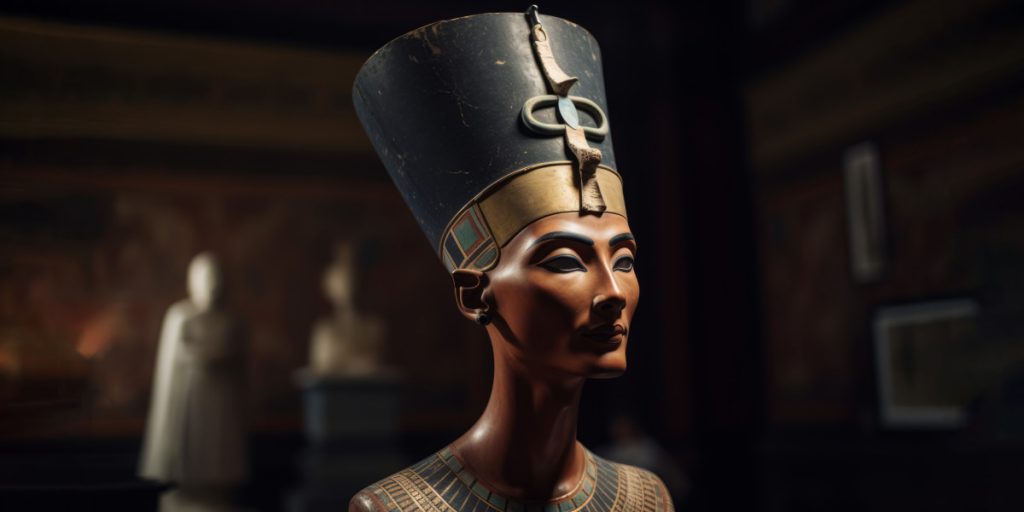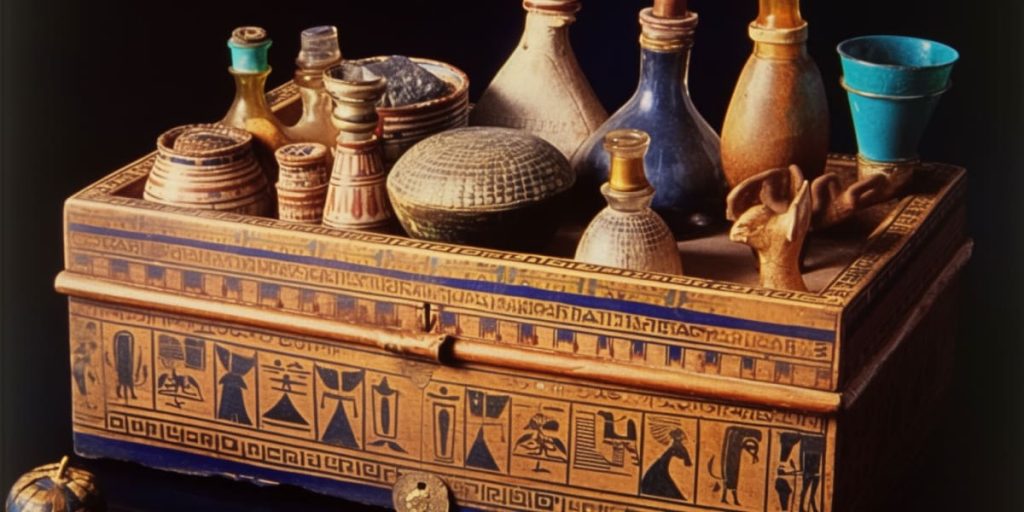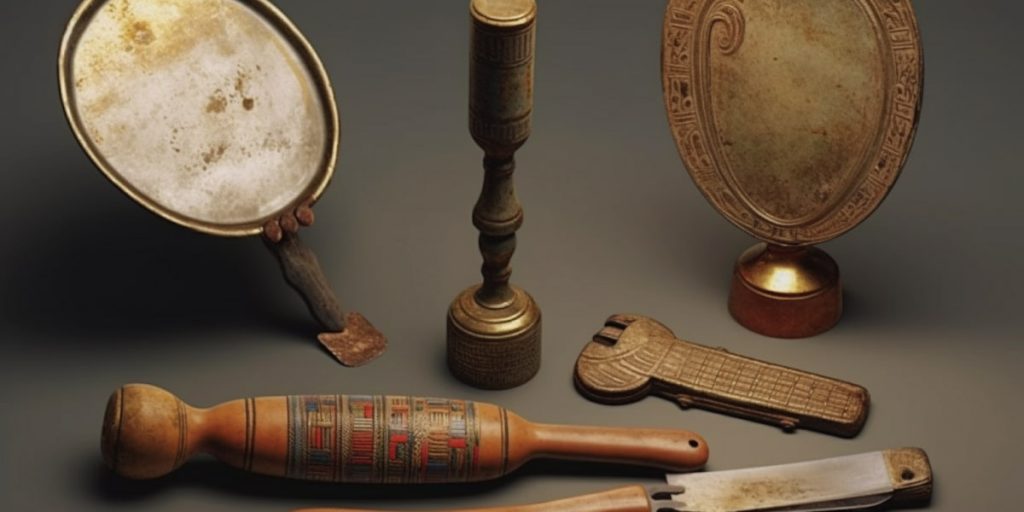Published on February 8th, 2024
Last updated on February 8th, 2024
Skincare for Acne-Prone Skin: Tips for Clearing and Preventing Breakouts

The Allure of Ancient Egyptian Beauty
They have left an indelible mark on the annals of history. The ancient Egyptian makeup captivates the imagination with its mystique and allure. A society influenced by mythology, spirituality, and the pursuit of eternal life. The concept of beauty extended far beyond the superficial. The Egyptians’ dedication to maintaining an aesthetic ideal wasn’t a quest for physical appeal. It profoundly reflects their cultural, religious, and social values. In cosmetics, men and women adorn themselves with various products. They transcend the mundane into the sacred. Kohl-lined eyes, rich pigments, and elaborate hairstyles weren’t simply embellishments. They have symbolic significance meaning. Ancient Egyptian cosmetics connect individuals to gods and embody images of protection.
Beyond cosmetics, the intricate jewelry and ornate accessories of the time spoke of a society. They revered craftsmanship and believed in the power of adornment to invoke divine favor. Each piece told a story, reflecting the wearer’s status, beliefs, and aspirations. This exploration into the allure of ancient Egyptian beauty unveils a civilization. We delve into the timeless enchantment. That lies within ancient Egypt’s cosmetic rituals and adornments. It reveals a beauty that transcends the ages. Appearance intertwined with the spiritual and decorative rituals had a sacred meaning. The pursuit of beauty was a journey into the very essence of existence.
Kohl Eyeliner and Mesmeric Gaze
In old Egyptian beauty, the mesmerizing allure of kohl eyeliner is an iconic symbol of cosmetic artistry. Dating back to around 1100 BCE, the ancient Egyptians’ eye makeup was a sacred, and symbolic practice:
- Kohl, a dark cosmetic powder, blends various substances. Among the ingredients are galena, malachite, and charcoal. They create a rich pigment that adorns both men’s and women’s eyes. The significance of eye makeup extends beyond the aesthetic. It delves into ancient Egyptian culture’s spiritual and protective realms.
- The distinctive almond shape achieved with kohl was not merely a beauty trend. It invokes the protection of the falcon god, Horus, warding off evil and ensuring a connection with the divine. The intricate application process involved precise lines and elaborate designs. Also, it transforms adorning the eyes into a ritualistic experience.
- Cleopatra’s beauty secrets are still popular. She is one of the most renowned figures of ancient Egypt. Cleopatra became synonymous with timeless beauty and sophistication. Her beauty secrets are full of the mystique of history. They have often included using kohl eyeliner to stress her eyes. Also, it creates an intense and captivating gaze.
- Cleopatra’s artful application of eye makeup enhanced her physical features. It served as a tool of empowerment and seduction. Also, it reinforces her allure as a powerful and enigmatic queen.
- The mesmerizing gaze achieved through ancient Egyptian eye makeup wasn’t confined to royalty. Both men and women from various social strata embraced these cosmetic practices. They emphasize the belief that beauty holds transformative and spiritual significance.
The legacy of kohl eyeliner endures as a testament to the profound interplay. It is between beauty and spirituality in ancient Egyptian culture. It leaves an indelible mark on the history of cosmetics and captivates the imagination of those who seek to unravel the secrets of the past.
Perfumes and Sensuous Scents

Perfumes played a central role in the aromatic tapestry of ancient Egyptian cosmetic rituals. They infuse the air with sensual scents that transcend the mundane and embrace the divine:
- The ancient Egyptians elevated the art of fragrance to a level of sophistication. Also, cultural significance remains unparalleled. Perfumes in ancient Egypt were not mere embellishments. They were integral to daily life, social interactions, and religious ceremonies. The crafting of perfumes involved an array of exotic ingredients. Among them are myrrh, frankincense, lotus, and cinnamon. They created olfactory masterpieces that reflected the luxury and refinement of the civilization. The scents were often blended into complex and harmonious compositions. They are evoking a sense of luxury and mystique.
- The useness of ancient Egyptian cosmetic perfumes extended beyond personal adornment. It was deeply entwined with spiritual practices. People believed that scents could invoke the favor of deities and ease communication with the divine. Temples were often filled with the heady fragrance of precious oils. They are enhancing the sacred atmosphere of religious ceremonies and rituals.
- Cleopatra celebrated for her beauty and allure and indulged in lavish perfumes. Her legendary meetings with Mark Antony infuse with rose petals, myrrh, and other exotic scents. They create an ambiance of seduction and luxury that heightens the sensory experience. The sensual allure of ancient Egyptian cosmetic perfumes wasn’t confined to the elite. Even the ordinary people embraced these aromatic indulgences.
- Perfumes became a form of self-expression. They help individuals to leave a lasting impression and enhance their allure. The intricate process of perfume application involved anointing various body parts. It includes the hair, neck, and wrists. Aroma cones made of wax or fat are carefully applied to the head. They melt throughout the day, releasing a continuous and subtle aroma.
As we delve into the scented legacy of ancient Egypt cosmetics, we find a civilization. That elevated the art of perfumery to new heights, infusing everyday life with an enchanting symphony of sensual scents. Perfumes as a cultural, social, and spiritual expression. They speak to the profound connection between beauty, ritual, and aromatic allure. That defined this captivating era.
Hair Care and Ornamentation
In the rich tapestry of Egyptian rituals, the care and ornamentation of hair emerged as a distinctive practice. It is weaving together elements of grooming, spirituality, and social identity:
- Dating back to around 1100 BCE, the ancient Egyptians meticulously approached hair care. That reflected their cultural values and aesthetic sensibilities. Hair was profoundly significant, often symbolizing vitality and life force.
- Both men and women took great care in maintaining their hair. They use a variety of natural ingredients. Among them are oils, perfumes, and ointments to nourish and style their tresses. The elaborate ancient Egyptian cosmetic hairstyles weren’t a matter of personal grooming.
- The famous Queen Nefertiti is the epitome of grace and beauty. She was often depicted with an iconic blue crown and an elaborate headdress. That accentuated her royal presence. Her iconic bust showcases a detailed hairstyle. That has become a symbol of the old Egyptian beauty ideals.
- Beyond the aesthetic, hair care rituals intertwine with spiritual beliefs. Using scented oils and perfumes not only added fragrance to the hair. It was also thought to have protective and purifying properties.
- The aromatic elements used in hair in ancient Egyptian cosmetic care rituals are not for their pleasant scents. It is for their symbolic associations with divine offerings and in rituals.
- Men, too, engaged in meticulous hair care practices. They do it with styles ranging from cropped cuts to more elaborate arrangements. Beards were often styled and sometimes adorned with beads or other decorative elements.
As we explore the intricacies of ancient Egyptian cosmetic hair care, we unveil a captivating blend of aesthetics. Also, symbolism and a profound connection between the physical and the spiritual realms.
Skin Nourishment and Hydration
In the old Egyptian beauty, the pursuit of glowing skin was a testament to a culture. That valued not only aesthetic appeal but also the nourishment and hydration of the skin. The meticulous care bestowed upon the skin unveils a holistic approach to beauty that transcends mere cosmetics:
- The ancient Egyptians were aware of the harsh desert climate. Their beauty rituals incorporate natural ingredients to protect and nourish the skin. Cleopatra, renowned for her legendary beauty, has employed a range of skincare secrets. They maintain her complexion’s lustrous glow.
- Cleopatra’s beauty secret is that she reportedly used a blend of milk and honey for moisturizing and soothing properties. It showcases an early understanding of the benefits of the natural ingredients in skincare. Cosmetics, including foundation and powders, were famous for aesthetic enhancement. It served practical purposes by providing a protective barrier against the sun and dry winds. These cosmetics are often made from crushed minerals and natural pigments. Its application contributes to preserving the skin’s moisture and suppleness.
- Ancient Egyptian cosmetics, based on oils and waxes, not only adorned the face but also served as a form of skincare. It is a deliberate choice of ingredients, such as castor and almond oil. It offers hydration and protection against the elements. It reflects a commitment to beauty and improvement of overall skin health.
- Skincare rituals extended beyond the elite, as shown by the discovery of skincare tools. Also, ancient Egyptian cosmetic containers are in various archaeological sites. Using alabaster jars for storing creams and ointments highlights the emphasis. It’s placed on preserving skincare products’ efficacy.
In essence, the ancient Egyptians approached beauty as a holistic try. It is recognizing that radiant skin wasn’t achieved through cosmetics. It also nourishes and hydrates the skin.
Mirrors and Grooming Tools

Mirrors and grooming tools have significantly enhanced beauty throughout history. They held cultural importance, especially in the context of ancient Egyptian eye makeup. The use of mirrors for grooming dates back to 1100 BCE, when people employed reflective surfaces to apply cosmetics. They are particularly adept at eye makeup and developed elaborate techniques around 110 BCE. The eyes were the center of beauty. Tools such as paint made from various minerals helped highlight their expressiveness. The significance of cosmetics extends beyond aesthetics. They were often associated with religious and spiritual practices.
Mirrors served not only as tools for personal grooming. They are also symbols of vanity and spirituality in ancient Egyptian society. The reflection in a mirror can capture the essence of one’s soul. Thus, mirrors and grooming tools in ancient Egypt were cultural, religious, and beauty practices. They showcase a sophisticated understanding of self-care and adornment. Cleopatra’s beauty secrets are in historical records, suggesting a fascination with cosmetics.
Spiritual and Magical Beauty
In the tapestry of history, the allure of spiritual and magical beauty is woven into the fabric of ancient civilizations. Among these, the ancient Egyptians stand out as masters of the cosmetic arts. They transcend mere aesthetics to embrace the divine. The captivating tale of Cleopatra’s beauty secrets lies at the heart of this enchantment. That resonates through the corridors of time:
- Cleopatra, the iconic Queen of the Nile, possessed an ethereal allure. That captivated not only the hearts of mighty men but also the imaginations of generations. Her beauty regimen included ancient makeup techniques bordering on the magical. With a critical focus on the eyes, Cleopatra harnessed the mystic power of kohl. It is an old cosmetic crafted with precision around 1100 BC. Such cosmetic shields the eyes from the harsh desert sun. Also, it transcended its practical purpose of becoming a spiritual protection and an alluring symbol.
- The ancient Egyptians were pioneers of beauty rituals. They embraced cosmetics, not merely as embellishments but as conduits to the divine. Cleopatra’s beauty secrets extended this profound philosophy. They blend physical adornment with spiritual significance. The eye makeup, with a history dating back to 1100 BC, wasn’t just a cosmetic. It symbolized protection, invoking the watchful gaze of deities.
- Ancient Egyptians adorned themselves with cosmetics because of their appearance and spiritual connection. That transcended the mundane. The base of ancient Egyptian makeup rituals is ancient traditions. They emphasize an understanding of the relationship between the physical and the metaphysical.
We find a testament to aesthetic refinement and a mystical journey into the realms of spiritual allure. That continues to captivate the human imagination.
Conclusion
The ancient Egyptians unveiled the secrets of spiritual and magical beauty. They are leaving an indelible mark on the canvas of human history. It is through the enigmatic allure of Cleopatra’s beauty secrets and the sacred strokes of ancient Egyptian eye makeup. They transcended mere aesthetics, reaching for the divine. We stand as a digital oracle, unraveling the mysteries of these ancient rituals. Also, our site offers a contemporary bridge to the timeless wisdom of the past. Here, the echoes of kohl-lined eyes and sacred cosmetics reverberate. It connects modern seekers with the enchantment of a bygone era. As we explore this virtual repository, we become pilgrims on a journey through the sacred corridors of beauty. There, the cosmetic arts are not just adornments but gateways to spiritual realms. In the convergence of ancient traditions, Beautysecretkeeper.com becomes a beacon. We guide you through the labyrinth of beauty with threads woven from the wisdom of the ages.
FAQ
What materials were used in ancient Egyptian cosmetics?
Ancient Egyptians crafted cosmetics utilizing a variety of natural materials. They include ground minerals like malachite and galena for pigments and kohl from soot or charcoal for eye makeup. Among them are beeswax and oils for ointments, too. They reflect a harmonious fusion of elements in their cosmetic concoctions.
Did men and women practice these beauty rituals in ancient Egypt?
Yes, both men and women in ancient Egypt engaged in beauty rituals. They use cosmetics and elaborate grooming practices as integral elements of daily life.
Are there any modern beauty products inspired by ancient Egyptian practices?
Yes, modern beauty products often take inspiration from ancient Egyptian practices. Eyeliner and skin care products contain unique ingredients. They are reminiscent of those favored by the ancient Egyptians. They are bridging the gap between historical beauty traditions and modern cosmetic innovations.

